Japan
Wood Products Prices
Dollar Exchange Rates
of
24th October 2013
Japan Yen 97.28
Reports From Japan
Weak exports growth a drag on business sentiment
In a press release Japan‟s Cabinet office says the
indications are that the economy is on the way to recovery
at a moderate pace despite the short term weakness in
exports.
See: http://www5.cao.go.jp/keizai3/getsureie/
2013oct.html
In summary the Cabinet Office statement says:
Exports are almost flat.
Industrial production is increasing but only at a
moderate pace.
Corporate profits are improving, mainly among
large firms.
Business investment shows signs of picking up,
mainly among non-manufacturing industries.
Business sentiment is improving.
The employment situation is improving.
The trend in private consumption up.
Regarding short-term prospects the Cabinet Office says,
“the recovery is expected to take hold as household
income and business investment continue to be on an
upward trend while exports pick up and the effects of the
policies develop. However, the slowing of overseas
economies is still a downside risk for the Japanese
economy.
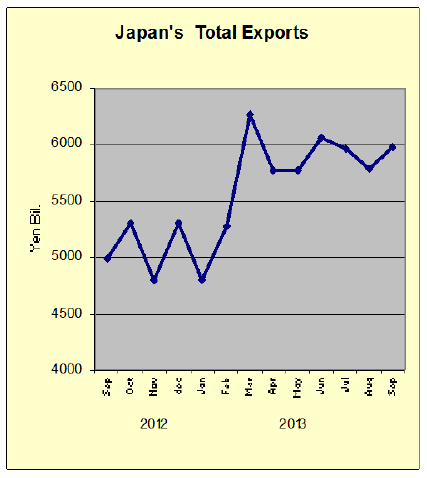
September data, while showing an improvement in exports
over levels in August year on year exports weakened
because Japan‟s exports to all major market slowed. This
was most notable in the Asian markets where the pace of
growth has faltered.
Exports to Asia increased 8% year on year, down from a
14% improvement in August however, shipments to China
increased. The pace of export growth to both the US and
EU eased in September.
Regional growth prospects positive but variable
The Bank of Japan (BoJ) produces a regional economic
report summarising data from the Bank‟s regional research
divisions and the October 2013 report is now available at:
http://www.boj.or.jp/en/research/brp/rer/rer131021.htm/
In a press release the BoJ says “Compared with the last
assessment in July 2013, all regions reported upward
revisions to their economic assessments from the previous
report, with some improvement observed in the
employment and income situation, amid firm domestic
demand and a moderate increase in production.
Eight regions (Hokkaido, Tohoku, Kanto-Koshinetsu,
Tokai, Kinki, Chugoku, Shikoku, and Kyushu-Okinawa)
noted that the economy had been recovering or recovering
moderately; the Hokuriku region reported that the
economy had been picking up steadily”.
Sustained GDP growth is key to decisions on
additional 2015 tax increase
The consumption tax in Japan will be raised from 5% to
8% in April 2014 and this is expected to impact growth
and consumer spending. The government plans a further
increase in the consumption to in October 2015 taking the
rate to 10%.
In a recent statement Japan‟s Finance Minister said the
performance of the economy as measured through GDP
growth will be the deciding factor on whether or not the
government will go ahead with the second consumption
13 ITTO TTM Report 17:20 16- 31 October 2013
tax hike adding that it will take some time for the Japanese
economy to escape deflation.
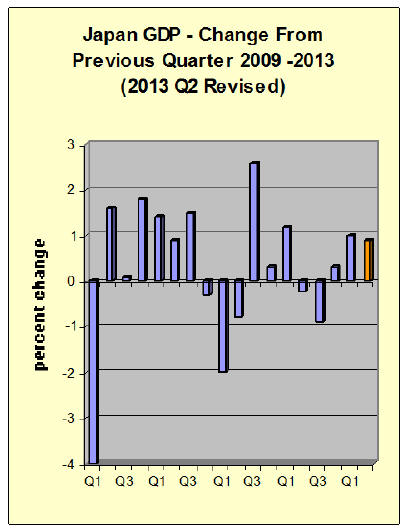
While the indications are that the economy is heading
towards a sustained growth track much more needs to be
done. Specifically, analysts are waiting for the government
to spell out its plan for reforming the economy.
Much needs to be done as Japan‟s labour productivity only
three quarters of that in the US and is in the same rank as
that of Italy. In addition the burden of inefficient and
highly costly health care and the massive agricultural
subsidies are a drag on growth.
If the TPP talks succeed then there is a chance for reform
but the agricultural sector will be hard hit. Already the
government has announced changes to the support
provided to rice farmers and under the TPP the US$ 50
billion subsidy package for farmers will have to be
adjusted.
Yen stability vital for exporters
Because of the debacle in the US the yen suddenly and
once more became a „safe haven‟ currency for worried
traders and this resulted in a strengthening of the yen
against major currency especially the US dollar.
Fortunately for businesses in Japan the yen has stabilized
back at the 97/98 to the dollar level targeted by the Bank
of Japan.
One of the greatest problems resulting from the weaker
yen is the rising trade deficit which is being pushed higher
mainly because the country needs to import fuel for power
generation as nuclear plants in the country are shut down.
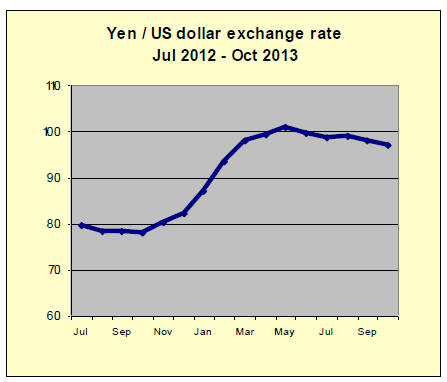
Housing starts may slow in 2014
The September rise in housing starts was not a great
surprise after the slight dip in starts in August. August is
the holiday month in Japan and almost all construction
companies close for around ten days.
The strong demand for new homes which began in April
this year has put pressure on wood product suppliers in the
country who have very firm order book positions.
Analysts suggest that the pace of growth in starts will slow
in 2014 as there has been a catch up phase after the 2011
disaster and that enthusiasm for beating the consumption
tax increase which is applied to home purchases will fade.
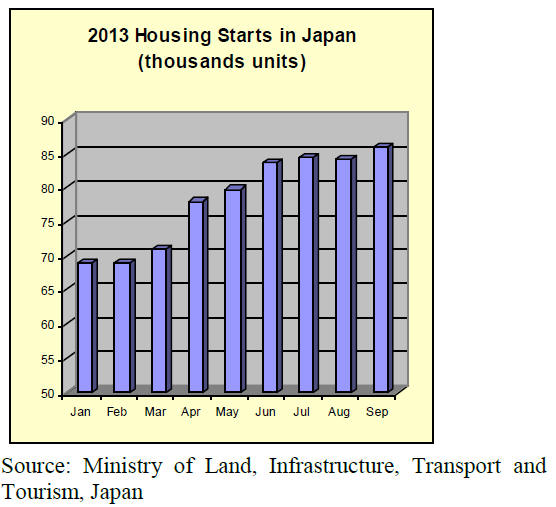
Trade news from the Japan Lumber Reports (JLR)
The Japan Lumber Reports (JLR), a subscription trade
journal published every two weeks in English, is
generously allowing the ITTO Tropical Timber Market
Report to extract and reproduce news on the Japanese
market.
The JLR requires that ITTO reproduces newsworthy text
exactly as it appears in their publication.
14 ITTO TTM Report 17:20 16- 31 October 2013
For the JLR report please see:
http://www.nmokuzai.
com/modules/general/index.php?id=7
Ranking of wood based house builders in 2012
Sumitomo Forestry became the top builders of wood based
units in 2012 with 9,253 after it developed new models
such as big frame construction and three stories unit. Tama
Home was the top builder in 2011 but its result in 2012
was forth with 7,981 units, which is about 20% down from
2011.
The second behind Sumitomo Forestry was Misawa Home
with 8,622 units, 3.8% more than 2011.
Top ten builders had generally gained over 2011 but
degree of increase was mild. They had larger plan in
expectation of reconstruction demand in earthquake
damaged areas in the North East and of marketing unit
with solar power generation as standard model but because
of shortage of workers, growth was not as large as the
builders initially planned.
In 2012, builders which put up units built for sale made
larger progress. Prices of property stayed rather low and
rush demand before consumption tax hike are reasons of
growth.
Foreign countries protest wood use point system
introduced by Japan
The Forestry Agency will respond to WTO on the protest
made by five foreign countries for the Wood Use Point
system the government is promoting. Foreign countries
think that the system conflicts with WTO‟s rule of equal
treatment by giving priority to domestic wood and
excluding foreign products.
At the WTO‟s meeting in July, Canada and EU made
protest and the U.S.A, New Zealand and Malaysia
supported the protest.
The Forestry Agency insists that regardless of species the
committee by well informed people makes proper
judgment based on information by certificate of origin,
growth of resources and spill-over effect to local economy.
Wood Use Point system is to give gift certificate if locally
produced wood is used for housing or wood products. The
certificate can be traded to locally produced agricultural or
marine products.
Point is given to the wood used may become a subject of
conflict but wood products in subject are not all locally
produced wood but over 50% in volume. Initial idea is to
maintain and preserve forest resources, to prevent from
global warming trend and to vitalize local economy.
The Minister of Natural Resources Ministry of British
Columbia, Canada visited Tokyo recently and made
speech, mentioning Wood Use Point system, which has
been concerned matter for wood products exporting
countries.
The Minister said that it is understandable that the measure
is to stimulate economy but access has to be opened for
foreign countries and be fair to treat imported wood
products.
British provincial government together with federal
government will request Japan that Canadian wood
products should be subject of the Wood Use Point system
to recognize Canada‟s timber management based on
sustained yield policy.
August plywood supply
Total supply in August was 515,600 cbms, 5.1% more
than the same month a year ago and 7.8% less than July.
About 44 M cbms less than July. In particular, plywood
import from Malaysia was the lowest this year. Also
domestic supply decreased due to summer vacation
season.
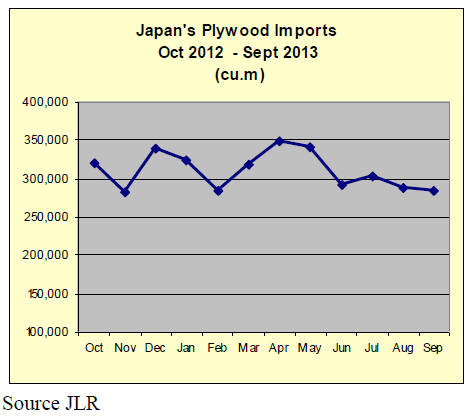
Imported plywood volume in August was 285,600 cbms,
2.3% less than August last year and 8.6% less than July.
Malaysian volume was 109,900 cbms, 17.9% less and
15.6% less. This is forth straight month decline.
Indonesian volume was 91,300 cbms, 15.6% more and
4.0% less.
Price gap between suppliers‟ prices and market prices in
Japan widened since last May on 12mm panels like
concreter forming so that contract volume has been
dropping. September arrivals would increase to about 300
m cbms due to ships‟ rotation then October arrivals would
decline again.
Increasing generation wood biomass power
The Forestry Agency disclosed that there are about 60
biomass generation projects in planning stage now.
The Agency for Natural Resources and Energy approved
18 biomass generation facilities based on FIT system as of
end on May. The Forestry Agency says there will be more
facilities not only of power generation but also of heat
supply from now on.
Planned wood biomass power generation facilities, which
use subsidy, are about 40. Total power output by those
facilities is about 350,000 KW. Ones without any subsidy
are about 20 facilities, which generate about 200,000 KW.
Also there are about 30 existing facilities with output of
1,200,000 KW, which shift to FIT system
Plywood market news
Domestic softwood plywood manufacturers have been
running in full since last spring to satisfy robust demand
by house builders and precutting plants so that the
inventories remain in low level.
This pattern seems to continue for some time. Normal
wholesale channels are also moving stably but because of
sales push by trading firms and wholesalers to have certain
amount of sales for book closing in September, sellers
suffer some loss but gradually the prices are getting close
to the manufacturers‟ proposed prices.
In the Tokyo market, 12 mm 3x6 plywood (special type/F
4 star) prices are 960 yen per sheet delivered, 10 yen up
from September; 1,900-1,920 yen on thick 24 mm panel,
20 yen up and long 9 mm 3x10 is flat at 1,400 yen.
Imported South Sea hardwood plywood market is
gradually recovering from the slump. Log shortage in
Malaysia and sudden change of exchange rate in early this
year caused speculative purchases for futures but the
demand did not grow as much as expected so that the
inventories swelled up by last summer.
The importers and wholesalers dumped some in late
September but such moves are now gone and the prices
are firming back up to early September level.
In the Tokyo market, prices of JAS 3x6 concrete forming
panel prices are 1,120-1,130 yen per sheet delivered, 20-
30 yen up from September. 1,220-1,240 yen on 3x6
concrete forming for coating, 10 yen up. 12 mm structural
panel prices are 1,130-1,140 yen, unchanged from
September. Malaysian offer prices on JAS 3x6 concrete
forming panel are slightly down from September at about
$520 per cbm C&F.
Price trends for imported Indonesian and Malaysian
plywood
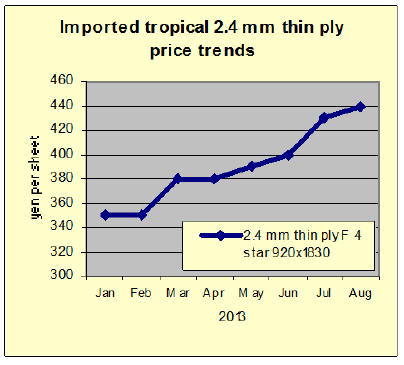 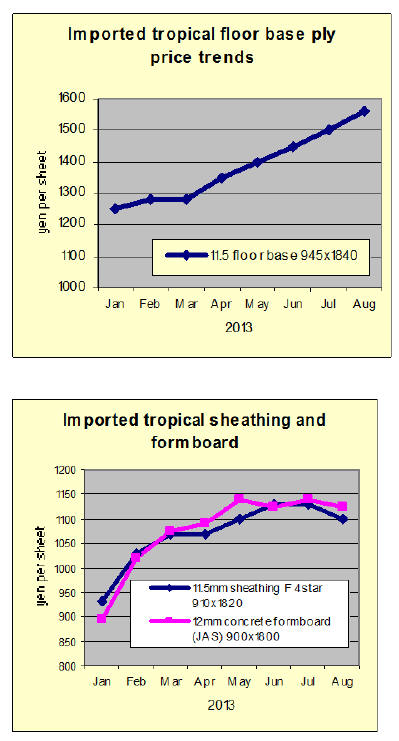
August 2013 furniture imports
The source and value of Japan‟s office, kitchen and
bedroom furniture imports for August 2013 are shown
below. Also illustrated is the trend in imports of office
furniture (HS 9403.30), kitchen furniture (HS 9403.40)
and bedroom furniture (HS 9403.50) between 2009 and
June 2013.
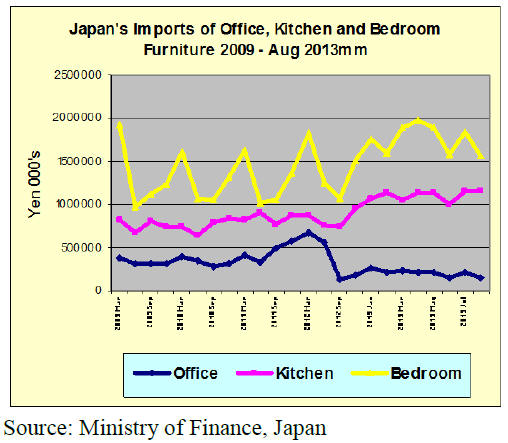
Office furniture imports (HS 9403.30)
In August 2013 Japan‟s imports of office furniture fell
around 30%from levels in July. The top four suppliers in
August were China, Poland, Portugal and Germany which
replaced Malaysia in the top four.
August imports of office furniture totaled yen 145 million
down sharply on levels in July with around 50% being
provided by exporters in Asia.
China‟s August office furniture exports to Japan at yen 48
mil. were down sharply (-32%) on levels in July. While
Japan‟s imports of office furniture from Malaysia
remained steady, Indonesia‟s exports were only half the
level in July. Imports from Germany increased in August
but Poland and Italy saw their share of imports fall.
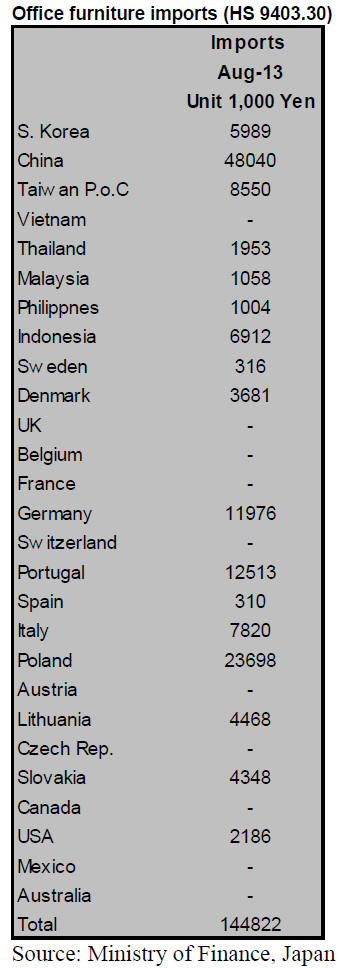
Kitchen furniture imports (HS 9403.40)
As was the case in July, Asian suppliers provided over
90% of all kitchen furniture imports by Japan according to
figures from Japan‟s Ministry of Finance. August kitchen
furniture imports, at yen 1,151 mil. were unchanged from
levels in July.
The top supplier in August was Vietnam, by a huge
margin. The Philippines lost its second place rank to and
Indonesia in August. The top three suppliers account for
over 65% of all kitchen furniture imports.
If imports of kitchen furniture from China are added to the
amount from the top three suppliers then some 80% of all
kitchen furniture imports are accounted for.
Imports from countries outside of Asia remain small and
once again imports from Germany fell while imports from
Italy increased.
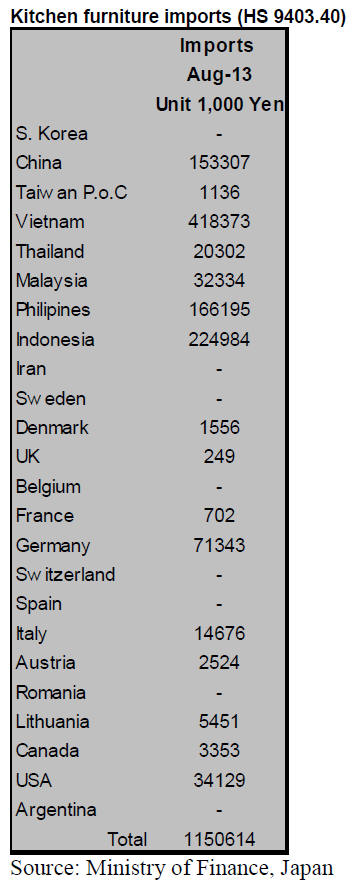
Bedroom furniture (HS 9403.50)
Japan‟s imports of bedroom furniture dipped to yen 1,560
mil. in August down on the yen 1,835 mil. in July but not
too much should be read into this change a monthly
imports of bedroom furniture swing from peaks to dips.
In August the biggest loser was China whose exports fell
around 20% from yen 1,033 in July to only yen 853 mil. in
August. Imports fro Vietnam, Indonesia and Thailand also
fell.
China‟s August exports of bedroom furniture to Japan
accounted for 55% of Japan‟s total imports of bedroom
furniture. Asian suppliers once more provided over 9% of
Japan‟s August imports of bedroom furniture.
The largest non-Asian supplier in August was Italy very
closely followed by Poland. EU suppliers accounted for
only a small part of Japan‟s August imports of bedroom
furniture.

|